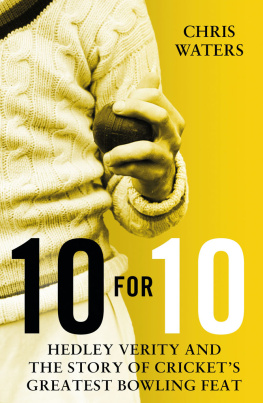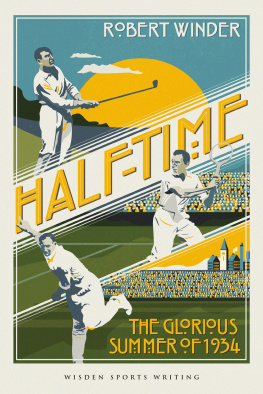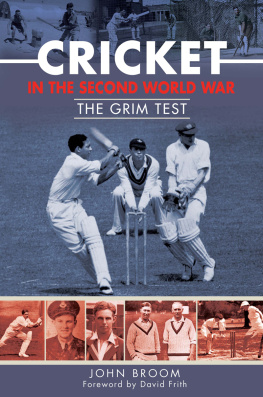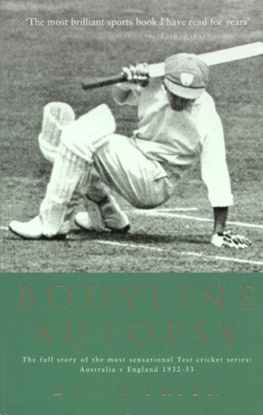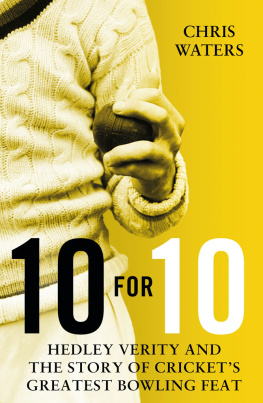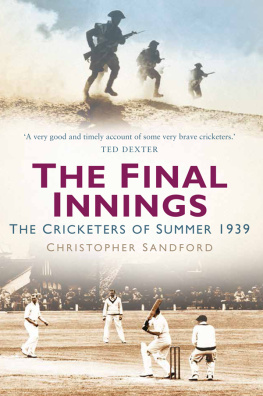
In memory of Douglas Verity
Verily, virile, Verity
With wonderful skill and dexterity
In a very few overs
He made Notts the rovers
A record to hand to posterity
A verse by a Mr J. B. Frecknall, of Carrington, published in the Nottingham Evening News on Saturday 16 July 1932, four days after Hedley Veritys record feat.
Cricketers rarely deal in statistical perfection. Don Bradmans Test average was 99.94, agonisingly short of the magical figure; Jim Laker took all but one of Australias 20 wickets during the Old Trafford Test of 1956, while Hanif Mohammad ran himself out on 499, for Karachi against Bahawalpur in 1959. If Bradman had managed just four more runs, Laker obtained just one more wicket, and Hanif successfully made good his ground, all would have brought off the beau ideal. As it was, they created new standards of excellence, inviting their fellows to go a step further. In 1932, however, came a feat so flawless, so symmetrically stunning, it was the nonpareil of numerical Utopia. Hedley Veritys 10 for 10, for Yorkshire versus Nottinghamshire at Leeds, has an air of amazement that glows to this day. Had it been 10 for 12, 10 for 11 or 10 for 9, it wouldnt have had the same striking impact, said Douglas Verity, a suitably proud son. Theres something about it that sounds so special; it just has a wonderfully musical ring. Veritys return sealed with seven wickets in 15 balls, including the hat-trick is the greatest recorded in first-class cricket. His full figures were 19.4 overs, 16 maidens, 10 runs, 10 wickets.
Even more incredible, Veritys feat was immediately followed by an unbroken stand of 139 between the Yorkshire opening batsmen Percy Holmes and Herbert Sutcliffe that took their team to a 10-wicket victory. On the same pitch on which Verity caused chaos, Holmes and Sutcliffe repelled an attack that included pace bowlers Harold Larwood and Bill Voce, whod gain notoriety that winter in the Bodyline series. Although Verity was helped by a drying surface after torrential rain, the consensus was that only part-explained his tour de force. According to newspaper reports, there was no rational reason for the disparity between his performance and that of Holmes and Sutcliffe. The wicket was never the vexatious proposition the Notts batsmen made it out to be, observed the Nottingham Evening News, while the Yorkshire Post declared that the pitch could not have changed so completely as the difference in the two innings would suggest. The Nottingham Journal said: The feat was sensational.
My own fascination with Veritys feat began when I chanced to meet one of his victims. In December 2000, my then employer, the Nottingham Evening Post, sent me to interview Frank Shipston, a former Nottinghamshire batsman whod become the oldest living county cricketer, aged 94, after the death of 103-year-old ex-Derbyshire batsman Jimmy Hutchinson. Although Shipston was a modest player who scored 1,183 runs in 49 first-class games at 18.48, I discovered while making some preliminary research that hed actually played in this phenomenal match. In fact, he was its last survivor and had been Veritys second victim, joint top-scoring with 21 along with fellow opener Walter Keeton.
When I visited Shipston at his home in Nottingham, the first words of a robust nonagenarian to the shy 20-something standing on his doorstep were full of smiling irony. Oh, youre a young chap, he chuckled. Shipston, a widower who lived with his son, Peter, and family, offered a warm handshake and led the way into a living room that contained no sign of his former occupation. Then, after modestly stating that I cant understand why anyone should want to interview a nothing cricketer like me, Shipston six-foot tall and strong-built cast his mind back 75 summers to the days of Jack Hobbs and Wally Hammond, tram cars and steam trains, cats whisker radios and silent pictures.
Ill never forget my first day at Trent Bridge, he announced, a faraway look in his kindly eyes. It was 1925 and Id gone for a trial after being spotted playing for my colliery team. I was putting on my pads when Jimmy Iremonger, the Notts coach, pulled me to one side. See that lad? he said, pointing to one of the bowlers in the distance. Hes a little bit quick, so watch the ball closely. I said, Thanks very much and got ready to take guard, although I took his words with a pinch of salt. Well, the first ball from this chap called Harold Larwood whizzed past at the speed of light and hit the net before Id seen it. The second hit me flush in the goolies and left me doubled-up in agony. One of the senior pros pointed out that I wasnt wearing a box. So there I was, batting against Larwood, and I wasnt even wearing a box; to be honest, I was so wet behind the ears I didnt know what a box was.
Despite his painful introduction, Shipston was awarded a three-year contract. He made his debut in the final match of the 1925 season, against Glamorgan at Swansea, exchanging life in the pits for life in the fresh air. Suddenly, I went from working in the pitch-black to enjoying lovely summers days all around the country, he recalled. I couldnt believe how lucky I was.
Although my newspaper only wanted an overview of Shipstons career, I was primarily interested in the 10 for 10. Mere mention of it drew an embarrassed laugh and a roll of the eyes, as though hed remembered some childhood caper. My word, the great Hedley Verity, sighed Shipston. What a name to conjure with. My companions voice trailed away and a sorrowful expression came over his face. He turned his head to look out of the window, staring sadly at the wintry scene. Killed in the war, of course, he whispered. Such a fine chap, and such a fine bowler.
The feat took place on the third and last day when the game appeared to be drifting to a draw. Nottinghamshire had scored 234 in their first innings, Yorkshire replying with 163 for nine before declaring at the start of the day to try to make a game of it. Shipston and Keeton made comfortable progress as Nottinghamshire sought to bat out time. They took the score to 44 for nought before the visitors collapsed to 67 all out, Holmes and Sutcliffe speeding Yorkshire home with their century partnership. Shipston corroborated newspaper reports that conditions were not over-biased towards Verity. I remember thered been a storm the night before and play began late on the final day, but you couldnt attribute Hedleys success to the state of the wicket. It offered him a certain amount of assistance, and he was able to get the ball to lift when the sun came out and dried the pitch, but Holmes and Sutcliffe put the conditions into proper context. As I recall, Hedley wasnt spinning it much just enough to find the edge. But thats all a spinner has to do.
Shipstons memories sepia-coated and clouded by time returned in dribs and drabs, like water dripping from a temperamental tap. He couldnt remember specific match detail and occasionally got frustrated. Im afraid I dont recall any of the wickets or anything, and I cant remember how I was out. Still, it was 70-odd years ago. These days, I have trouble remembering what I did yesterday. However, Shipston did his best to satisfy my interest even though it seemed almost painful to think back so far. Its funny, but the thing that sticks in my mind is that I ended up with the captains batting gloves. Arthur Carr was the Notts captain and quite a character. He used to frighten me because you never knew what hed do next. I remember a game at Cardiff. After the lads had been drinking at night, Carr walked on to the pitch, whipped out his middle stump and watered the wicket, encouraging the rest of us to follow suit. He reckoned the pitch had been favouring the batsmen. Anyway, when Verity got him that day at Leeds, Carr stormed back to the dressing room and threw his green batting gloves on to the floor. The gloves happened to land at my feet. You can ruddy well have em, he said.
Next page
